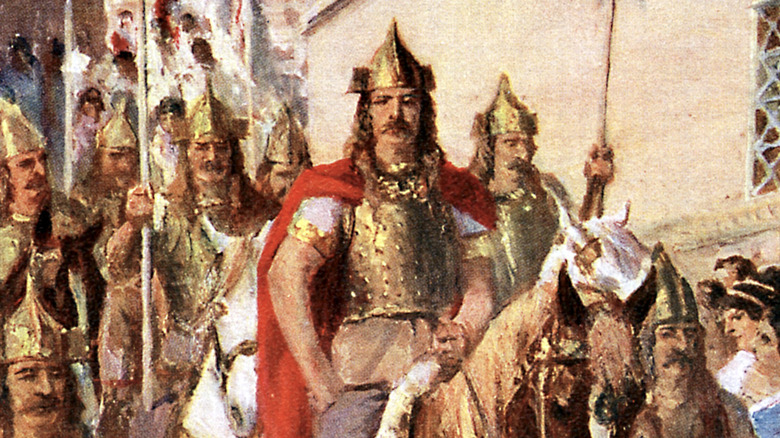King Alaric's Gold: The Hidden Treasure The Nazis Couldn't Find
Ruling with an iron fist in the days of the Third Reich, Adolf Hitler was known for his brutality, along with his antisemitic and racist worldview that there was a "master race" of Aryans who were meant to dominate the planet. This largely spurred what later became known as the Holocaust, a systematic genocide that resulted in the deaths of 6 million Jews in Europe, and an additional 5 million non-Jews. While Hitler's unspeakable horrors, hateful ideologies, and reputation as a crazed fascist dictator are all common knowledge, there are many who might not be aware that he was, by and large, a very superstitious man.
As Stetson University Professor Eric Kurlander explained in a 2020 scholarly article published by MHQ — The Quarterly Journal of Military History (via HistoryNet), Hitler's apparent obsession with the occult — which was shared with many other high-ranking Nazis — spurred them to facilitate missions for obscure artifacts. Generally, these supposed artifacts were fabled in ancient myths or eccentric stories. One of these, one mission in particular — the quest for the Visigoth King Alaric I, known more popularly as King Alaric — would be fruitless. But even now, it still begs a series of questions. Why were the Nazis so superstitious? What does that have to do with King Alaric's supposed gold? And if it exists, why did the Nazis fail at locating it?
Adolf Hitler's Nazi empire was literally built upon myth
Leaders of the Nazi regime like Adolf Hitler and SS leader Heinrich Himmler were avid astrologers and mystics, who often had their own astrology charts and collection of mystic objects, which would lead them on treasure hunts around Germany for artifacts (via HistoryNet). As the U.K. Independent noted in 2007, Himmler himself launched a 1940 expedition in Spain in order to find and secure the Holy Grail for Nazi Germany. It was hardly his only venture for mythical relics: Per the Sky HISTORY channel, Himmler also reportedly ordered German archaeologists to search for the hammer attributed to Thor, a deity found in Norse mythology.
Himmler, it can be argued, was more enmeshed in the concepts of mysticism and esotericism than Hitler. A lot of this went hand-in-hand with his belief in a supreme German race. According to Sky HISTORY, Himmler often looked to ancient history and German myths in order to reinstate a new world, one founded on a mix containing parts of Christian and Gnostic teachings, as well as elements of pre-Christian Germanic culture. He even interpreted the SS to be a representation of the Teutonic Knights, which were formed during the Crusades in Europe and had many similarities to the Knights Templar, per Sky HISTORY. The Nazi regime's search for these ancient treasures eventually led them to their eventual failed pursuit of King Alaric's gold.
The Nazis were obsessed with the figure of King Alaric
In the late fourth century A.D., tensions simmered between the western contingent of a divided Roman Empire and the leaders of Gothic tribes. By that time, Western Rome was in a precarious place compared to the days of Julius Caesar and Emperor Augustus. In order to stave off a possible invasion after a referred to by historians as the Gothic War, the Gothics agreed to settle in the Balkans, but as allies, not official citizens (via World History Encylopedia). Unfortunately, this allowed the Roman Empire to exploit the Gothics, especially when it came to mandatory conscription in the Roman Army, where Gothic soldiers became little more than bona fide body shields.
This all came to a head around 395 A.D. when forces led by a Visigoth king named Alaric I eventually waged war against their Roman overlords and more or less didn't stop until 410 A.D., with a few intermittent failed negotiations and ceasefires thrown in for good measure (via World History), and successfully attacked Rome twice. However, what drew the Nazis to King Alric had very little to do with the historical facts and more to do with somewhat apocryphal fare. Their obsession with King Alric was harnessed to the Visigoth leader's purportedly "lost treasure," which supposedly disappeared after King Alric's death in the early fifth century during a military campaign.
Hitler deployed an official mission to recover King Alaric's gold
Way before Adolf Hitler became Germany's leader, the country's economy was left in shambles following its defeat in World War I. Upon Hitler's rise to power in 1933, he helped reinvigorate Germany's financial system by way of its military-industrial complex, along with unifying German citizens against its disenfranchised Jewish population, per the Atlantic. As the German treasure vaults amassed more wealth, the Nazis set their sights on more gold — which, in turn, led to the search for King Alric's lost treasure (via HistoryNet).
As the U.K. Telegraph reported in 2015, Hitler assigned Himmler and his cohort to search for King Alric's grave, which they believed would also be the location of his riches. They surmised that Alric's resting place was somewhere near the Calabrian city of Cosenza in Southern Italy, where various historical narratives had alluded to as his burial site. But despite working with a team of archaeologists, Himmler failed to locate neither grave nor treasure before the Third Reich fell in 1945.
But that doesn't mean others still aren't out there looking. In 2015, Italian archaeologists working in part with the University of Calabria set out to recover King Alaric's treasure, per the U.K. Telegraph; as of this writing, neither King Alaric's tomb nor great riches have been found.



